Investigation of Partial Shading Scenarios on a Photovoltaic Array’s Characteristics
Abstract
:1. Introduction
2. PV Characteristics under Uniform Irradiance Conditions
3. PV Characteristics under Non-Uniform Irradiance Conditions
4. Results and Discussion
- (i)
- The first peak was created by the unshaded PV panels;
- (ii)
- The second peak was affected by shading on the PV panels;
- (iii)
- The localization of the GMPP was influenced by the irradiance value of the unshaded panels and the number of shaded panels.
5. Conclusions
- (1)
- Finding the critical point in the form of an equation using a multiple regression algorithm or an artificial intelligence algorithm, which will allow us to know the area of the global peak in order to control the DC/DC converter using the two equations given in this work: Equation (1) when the GMPP is located at the first peak and Equation (2) when the GMPP is located at the second peak;
- (2)
- Design a GMPPT controller based on the proposed method and validate its feasibility of implementation in a real PV system.
Author Contributions
Funding
Institutional Review Board Statement
Informed Consent Statement
Data Availability Statement
Acknowledgments
Conflicts of Interest
References
- Azeroual, M.; El Makrini, A.; El Moussaoui, H.; EL Markhi, H. Renewable Energy Potential and Available Capacity for Wind and Solar Power in Morocco Towards 2030. J. Eng. Sci. Technol. Rev. 2018, 11, 189–198. [Google Scholar] [CrossRef]
- Kousksou, T.; Allouhi, A.; Belattar, M.; Jamil, A.; El Rhafiki, T.; Arid, A.; Zeraouli, Y. Renewable energy potential and national policy directions for sustainable development in Morocco. Renew. Sustain. Energy Rev. 2015, 47, 46–57. [Google Scholar] [CrossRef]
- Xenophontos, A.; Bazzi, A.M. Model-based maximum power curves of solar photovoltaic panels under partial shading conditions. IEEE J. Photovolt. 2018, 8, 233–238. [Google Scholar] [CrossRef]
- Fesharaki, V.J.; Dehghani, M.; Fesharaki, J.J.; Tavasoli, H. The effect of temperature on photovoltaic cell efficiency. In Proceedings of the 1st International Conference on Emerging Trends in Energy Conservation–ETEC, Tehran, Iran, 20–21 November 2011; pp. 20–21. [Google Scholar]
- Ahmad, R.; Murtaza, A.F.; Sher, H.A. Power tracking techniques for efficient operation of photovoltaic array in solar applications–A review. Renew. Sustain. Energy Rev. 2019, 101, 82–102. [Google Scholar] [CrossRef]
- Motahhir, S.; El Hammoumi, A.; El Ghzizal, A. The most used MPPT algorithms: Review and the suitable low-cost embedded board for each algorithm. J. Clean. Prod. 2020, 246, 118983. [Google Scholar] [CrossRef]
- Chalh, A.; Motahhir, S.; El Hammoumi, A.; El Ghzizal, A.; Derouich, A. Study of a low-cost PV emulator for testing MPPT algorithm under fast irradiation and temperature change. Technol. Econ. Smart Grids Sustain. Energy 2018, 3, 11. [Google Scholar] [CrossRef] [Green Version]
- Chalh, A.; Motahhir, S.; El Hammoumi, A.; El Ghzizal, A.; Derouich, A. A low-cost PV Emulator for testing MPPT algorithm. IOP Conf. Ser. Earth Environ. Sci. 2018, 161, 012018. [Google Scholar] [CrossRef] [Green Version]
- Silvestre, S.; Chouder, A. Effects of shadowing on photovoltaic module performance. Prog. Photovolt. Res. Appl. 2008, 16, 141–149. [Google Scholar] [CrossRef]
- Silvestre, S.; Boronat, A.; Chouder, A. Study of bypass diodes configuration on PV modules. Appl. Energy 2009, 86, 1632–1640. [Google Scholar] [CrossRef]
- Dhimish, M. Assessing MPPT techniques on hot-spotted and partially shaded photovoltaic modules: Comprehensive review based on experimental data. IEEE Trans. Electron Devices 2019, 66, 1132–1144. [Google Scholar] [CrossRef] [Green Version]
- Bruendlinger, R.; Bletterie, B.; Milde, M.; Oldenkamp, H. Maximum power point tracking performance under partially shaded PV array conditions. In Proceedings of the 21st European Photovoltaic Solar Energy Conference, Dresden, Germany, 4–8 September 2006; pp. 2157–2160. [Google Scholar]
- Petrone, G.; Spagnuolo, G.; Teodorescu, R.; Veerachary, M.; Vitelli, M. Reliability issues in photovoltaic power processing systems. IEEE Trans. Ind. Electron. 2008, 55, 2569–2580. [Google Scholar] [CrossRef]
- Maghami, M.R.; Hizam, H.; Gomes, C.; Radzi, M.A.; Rezadad, M.I.; Hajighorbani, S. Power loss due to soiling on solar panel: A review. Renew. Sustain. Energy Rev. 2016, 59, 1307–1316. [Google Scholar] [CrossRef] [Green Version]
- Ahmed, J.; Salam, Z. A critical evaluation on maximum power point tracking methods for partial shading in PV systems. Renew. Sustain. Energy Rev. 2015, 47, 933–953. [Google Scholar] [CrossRef]
- Chalh, A.; El Hammoumi, A.; Motahhir, S.; El Ghzizal, A.; Subramaniam, U.; Derouich, A. Trusted Simulation Using Proteus Model for a PV System: Test Case of an Improved HC MPPT Algorithm. Energies 2020, 13, 1943. [Google Scholar] [CrossRef] [Green Version]
- Winston, P.; Kumar, B.P.; Christabel, S.C.; Chamkha, A.J.; Sathyamurthy, R. Maximum power extraction in solar renewable power system-a bypass diode scanning approach. Comput. Electr. Eng. 2018, 70, 122–136. [Google Scholar] [CrossRef]
- Motahhir, S.; Chouder, A.; El Hammoumi, A.; Benyoucef, A.S.; El Ghzizal, A.; Kichou, S.; Kara, K.; Sanjeevikumar, P.; Silvestre, S. Optimal Energy Harvesting From a Multistrings PV Generator Based on Artificial Bee Colony Algorithm. IEEE Syst. J. 2020, 15, 4137–4144. [Google Scholar] [CrossRef]
- Chalh, A.; El Hammoumi, A.; Motahhir, S.; EL Ghzizal, A.; Derouich, A. Development of an Improved GMPPT Based on Scanning Method for PV System Operating under a Dynamic Partial Shading Conditions. Technol. Econ. Smart Grids Sustain. Energy 2021, 6, 19. [Google Scholar] [CrossRef]
- Salam, Z.; Ahmed, J.; Merugu, B.S. The application of soft computing methods for MPPT of PV system: A technological and status review. Appl. Energy 2013, 107, 135–148. [Google Scholar] [CrossRef]
- Chao, K.-H.; Lin, Y.-S.; Lai, U.-D. Improved particle swarm optimization for maximum power point tracking in photovoltaic module arrays. Appl. Energy 2015, 158, 609–618. [Google Scholar] [CrossRef]
- Eltamaly, A.M.; Farh, H.M.H.; Abokhalil, A.G. A novel PSO strategy for improving dynamic change partial shading photovoltaic maximum power point tracker. Energy Sources Part A Recover. Util. Environ. Eff. 2020, 29, 1–15. [Google Scholar] [CrossRef]
- Patel, H.; Agarwal, V. MATLAB-based modeling to study the effects of partial shading on PV array characteristics. IEEE Trans. Energy Convers. 2008, 23, 302–310. [Google Scholar] [CrossRef]
- Pendem, S.R.; Mikkili, S. Modelling and performance assessment of PV array topologies under partial shading conditions to mitigate the mismatching power losses. Sol. Energy 2018, 160, 303–321. [Google Scholar] [CrossRef]
- Ma, J.; Pan, X.; Man, K.L.; Li, X.; Wen, H.; Ting, T.O. Detection and assessment of partial shading scenarios on photovoltaic strings. IEEE Trans. Ind. Appl. 2018, 54, 6279–6289. [Google Scholar] [CrossRef]
- Salem, F.; Awadallah, M.A. Detection and assessment of partial shading in photovoltaic arrays. J. Electr. Syst. Inf. Technol. 2016, 3, 23–32. [Google Scholar] [CrossRef] [Green Version]
- Zhao, J.; Zhou, X.; Ma, Y.; Liu, Y. Analysis of dynamic characteristic for solar arrays in series and global maximum power point tracking based on optimal initial value incremental conductance strategy under partially shaded conditions. Energies 2017, 10, 120. [Google Scholar] [CrossRef] [Green Version]
- Teo, J.C.; Tan, R.H.G.; Mok, V.H.; Ramachandaramurthy, V.K.; Tan, C. Impact of partial shading on the PV characteristics and the maximum power of a photovoltaic string. Energies 2018, 11, 1860. [Google Scholar] [CrossRef] [Green Version]
- Villalva, M.G.; Gazoli, J.R.; Filho, E.R. Comprehensive approach to modeling and simulation of photovoltaic arrays. IEEE Trans. Power Electron. 2009, 24, 1198–1208. [Google Scholar] [CrossRef]
- TDC-M20-36 Solar Panel. 2018. Available online: https://tdcsolar.en.alibaba.com/product/60018196685-220763581/20w_mono_small_solar_panel_from_chinese_factory.html?spm=a2700.8304367.rect38f22d.16.47185198OcAXoD (accessed on 10 January 2018).
- Motahhir, S.; El Ghzizal, A.; Sebti, S.; Derouich, A. Shading effect to energy withdrawn from the photovoltaic panel and implementation of DMPPT using C language. Int. Rev. Autom. Control 2016, 9, 88–94. [Google Scholar] [CrossRef]
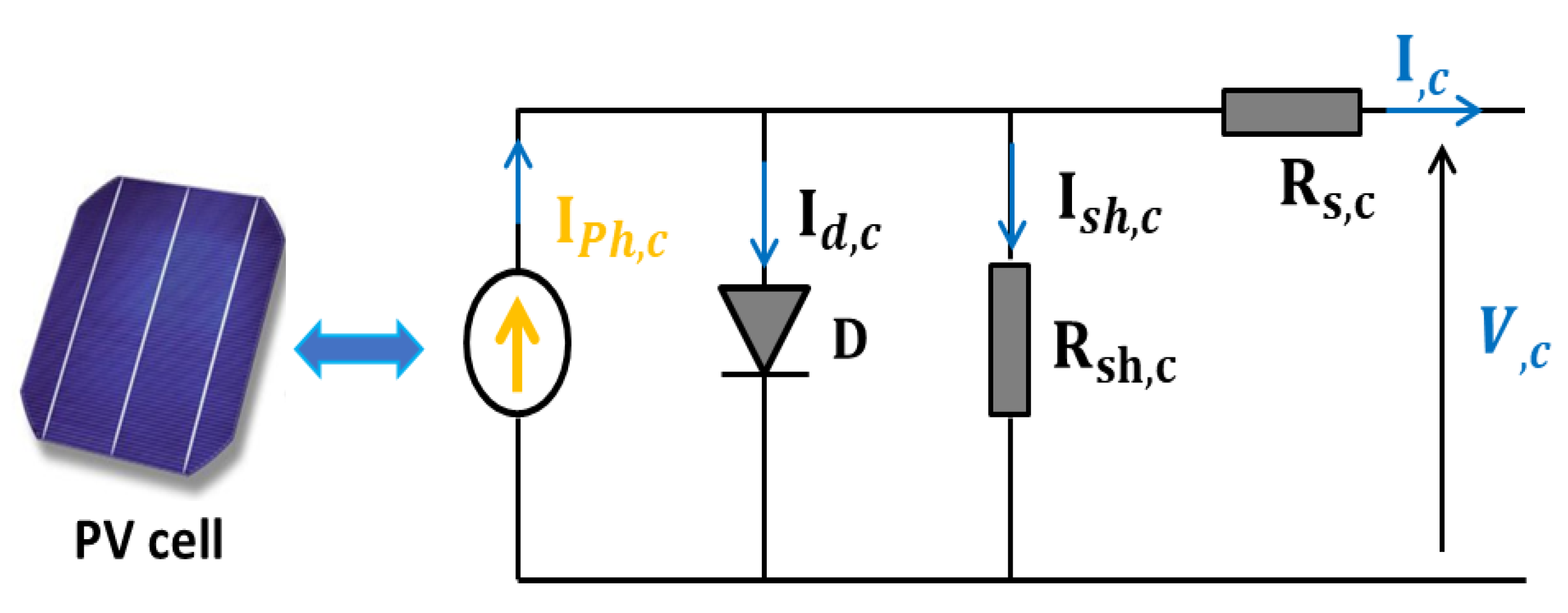
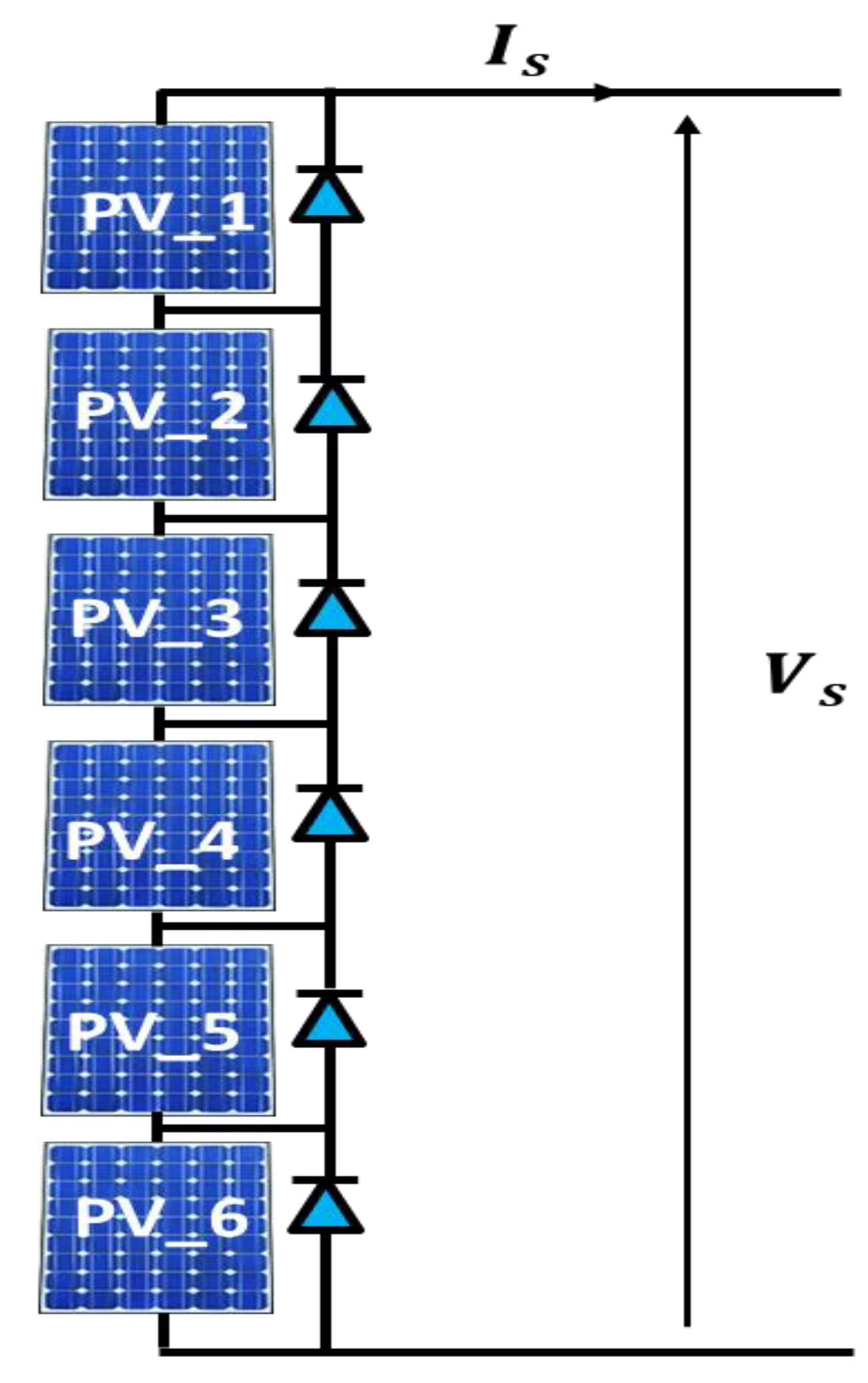
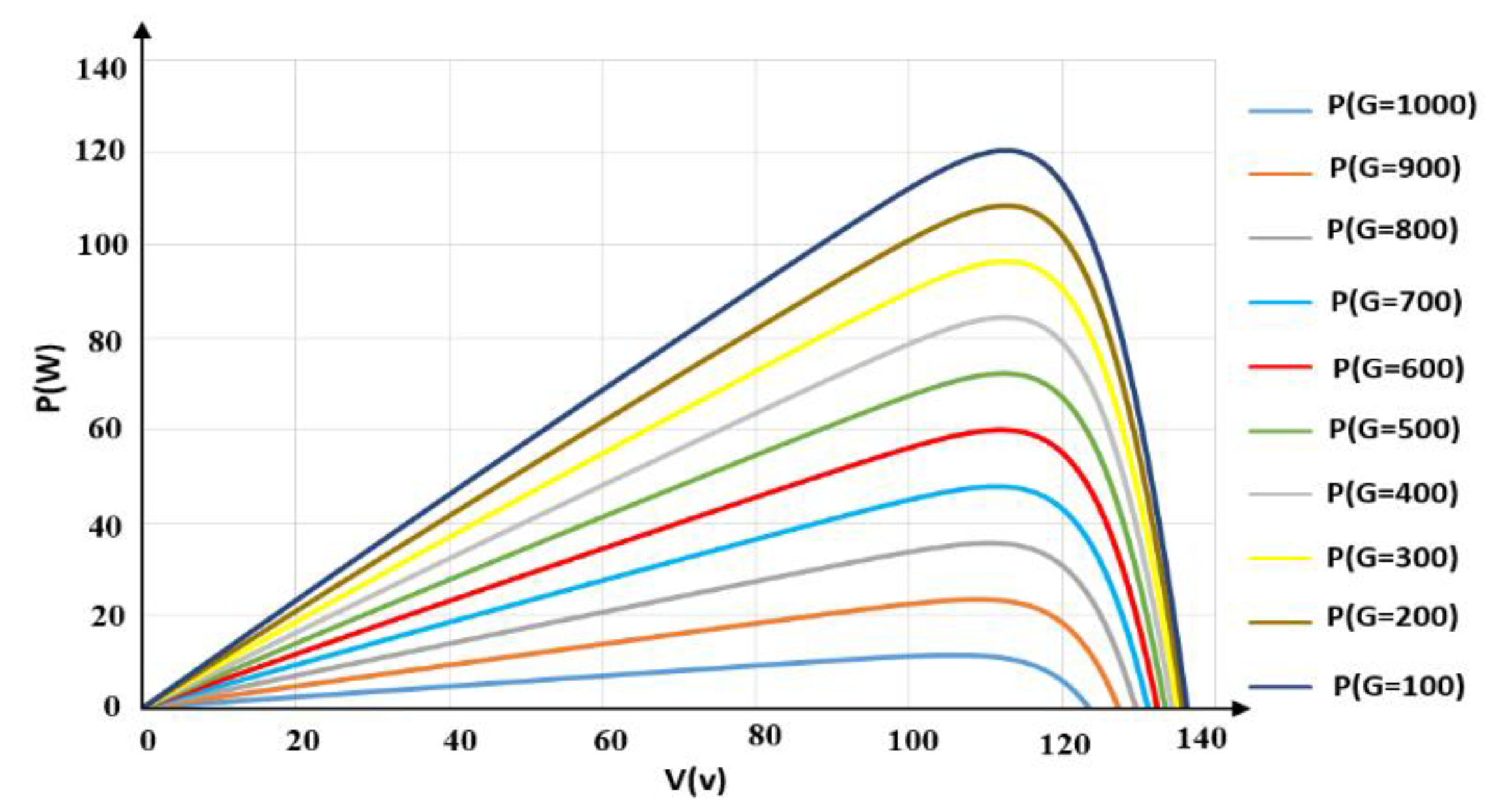
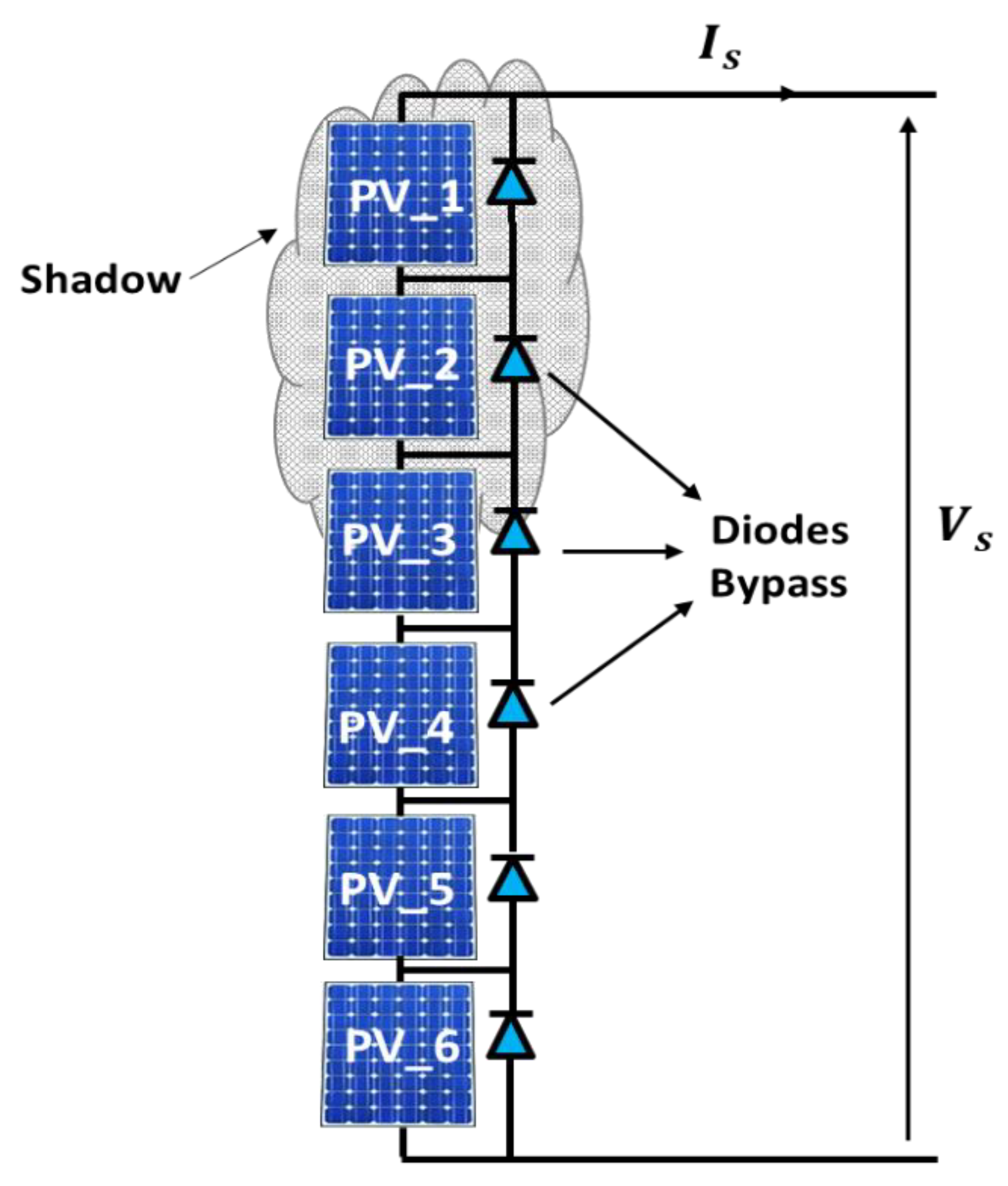
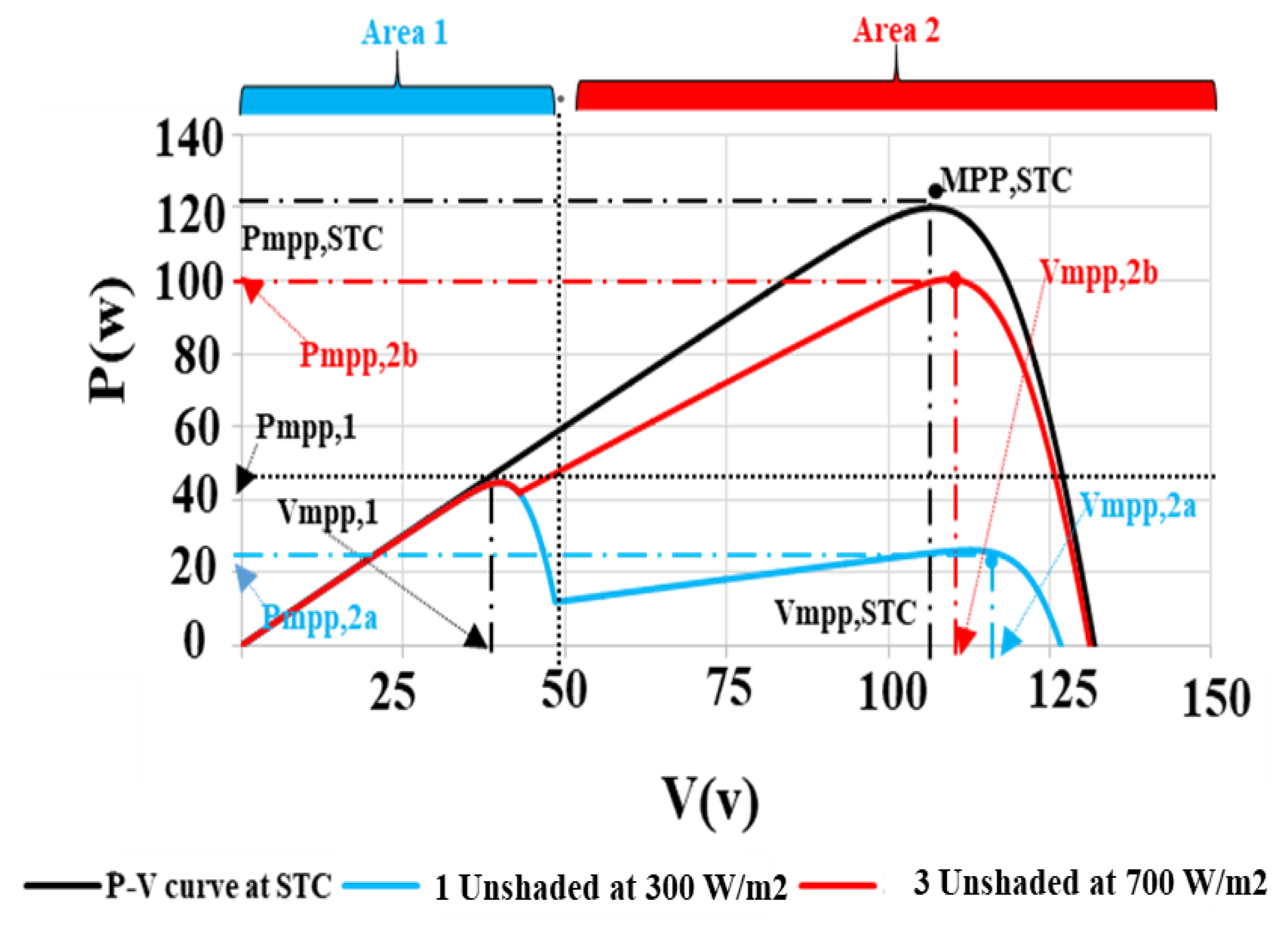
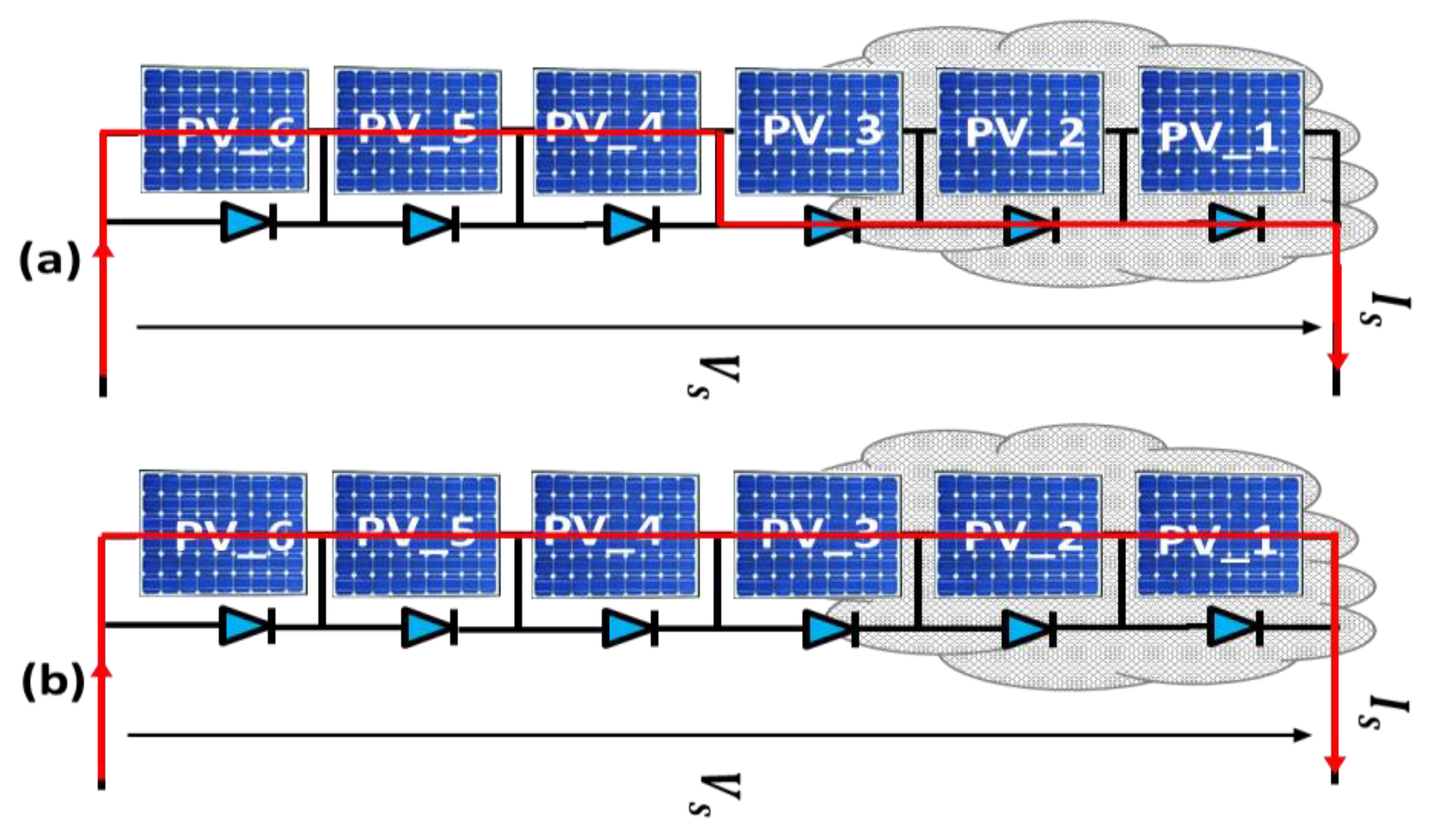
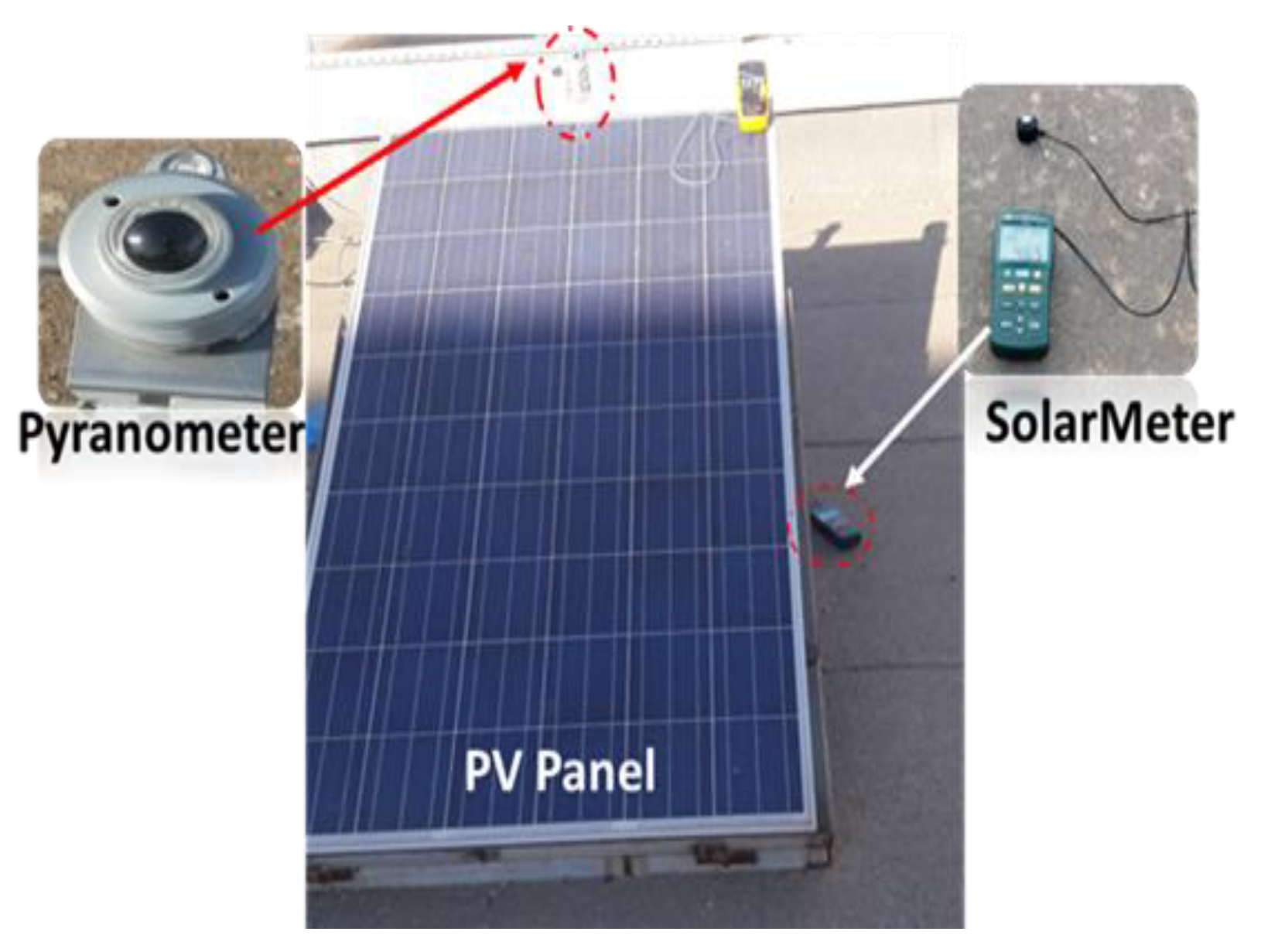
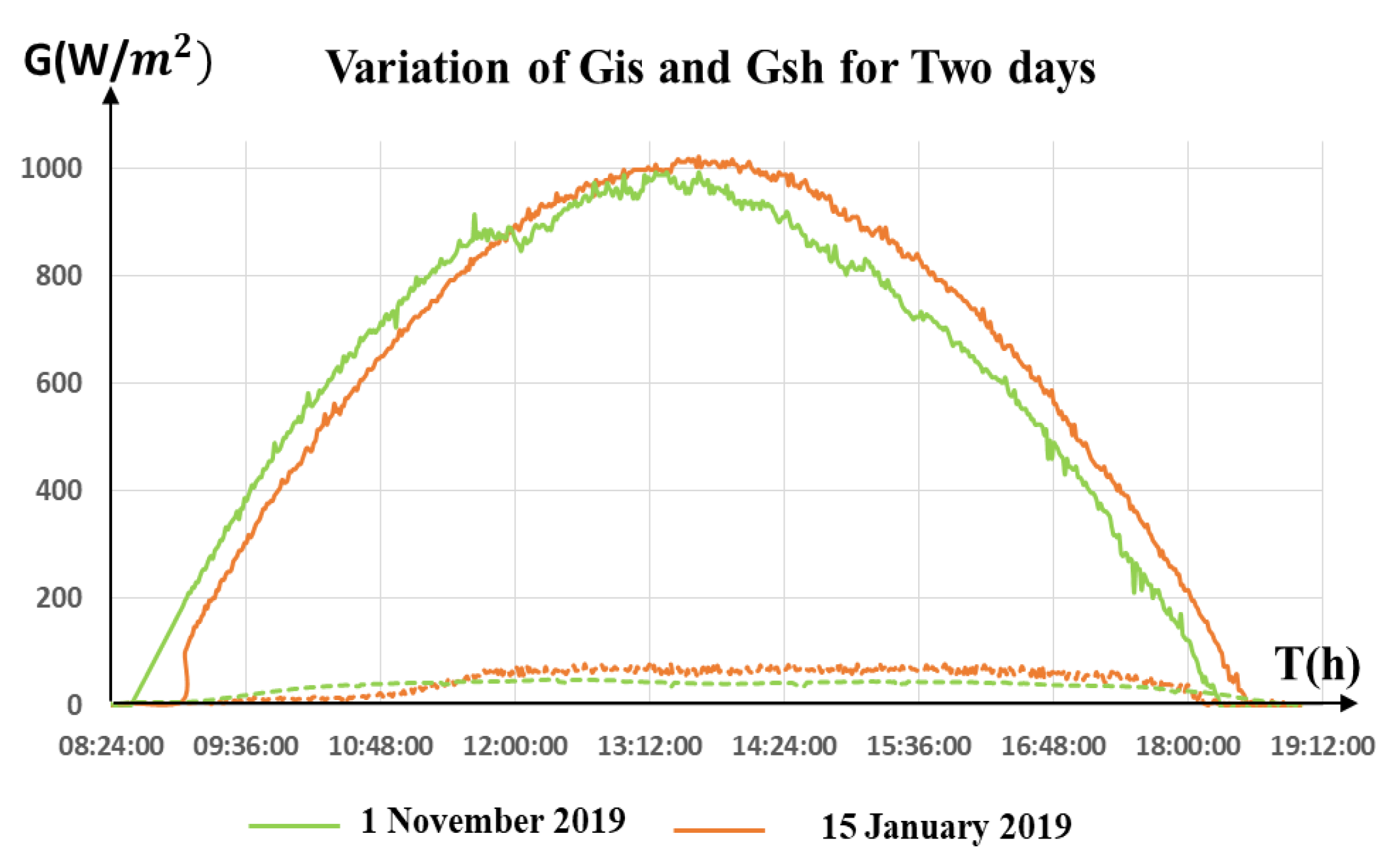
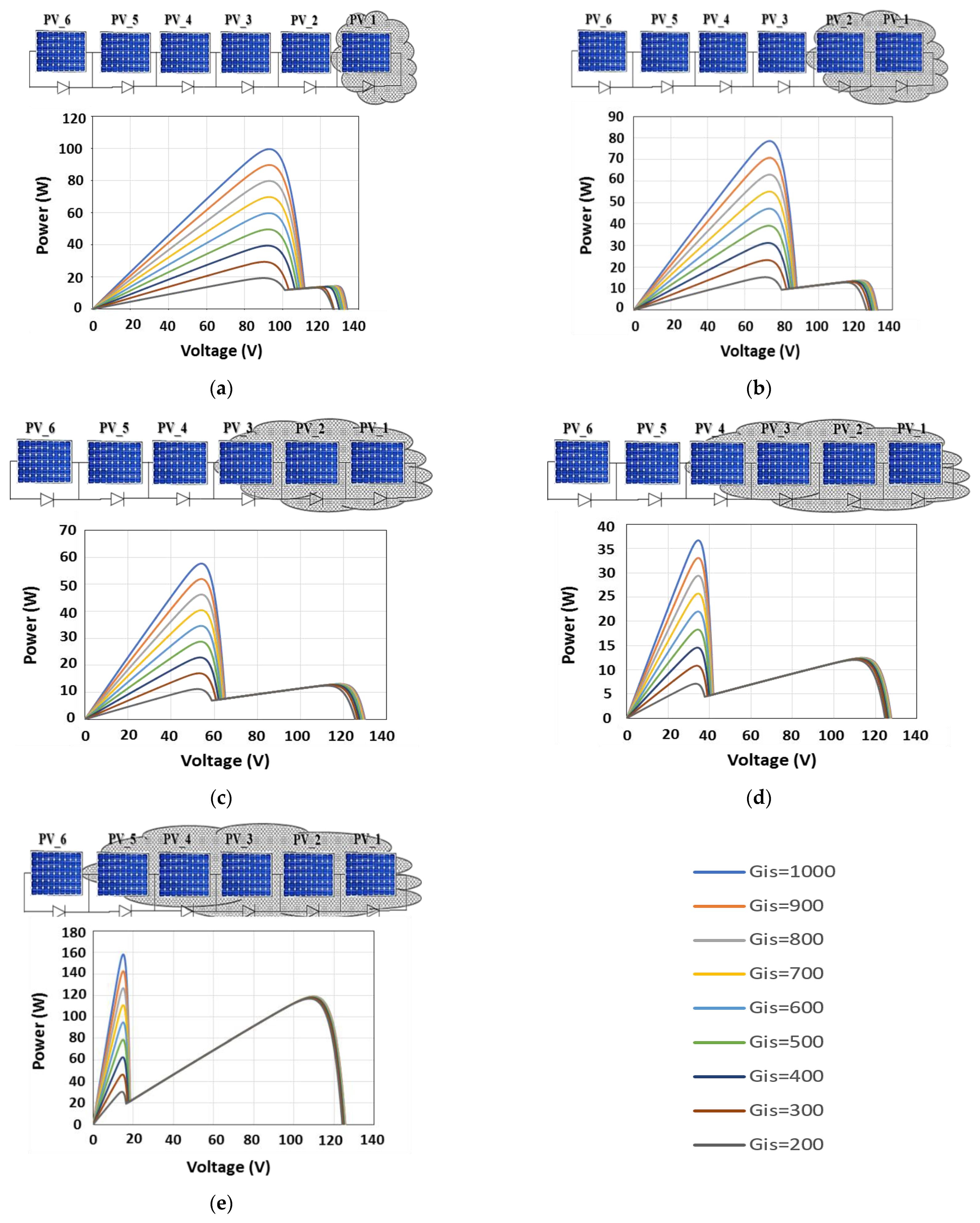
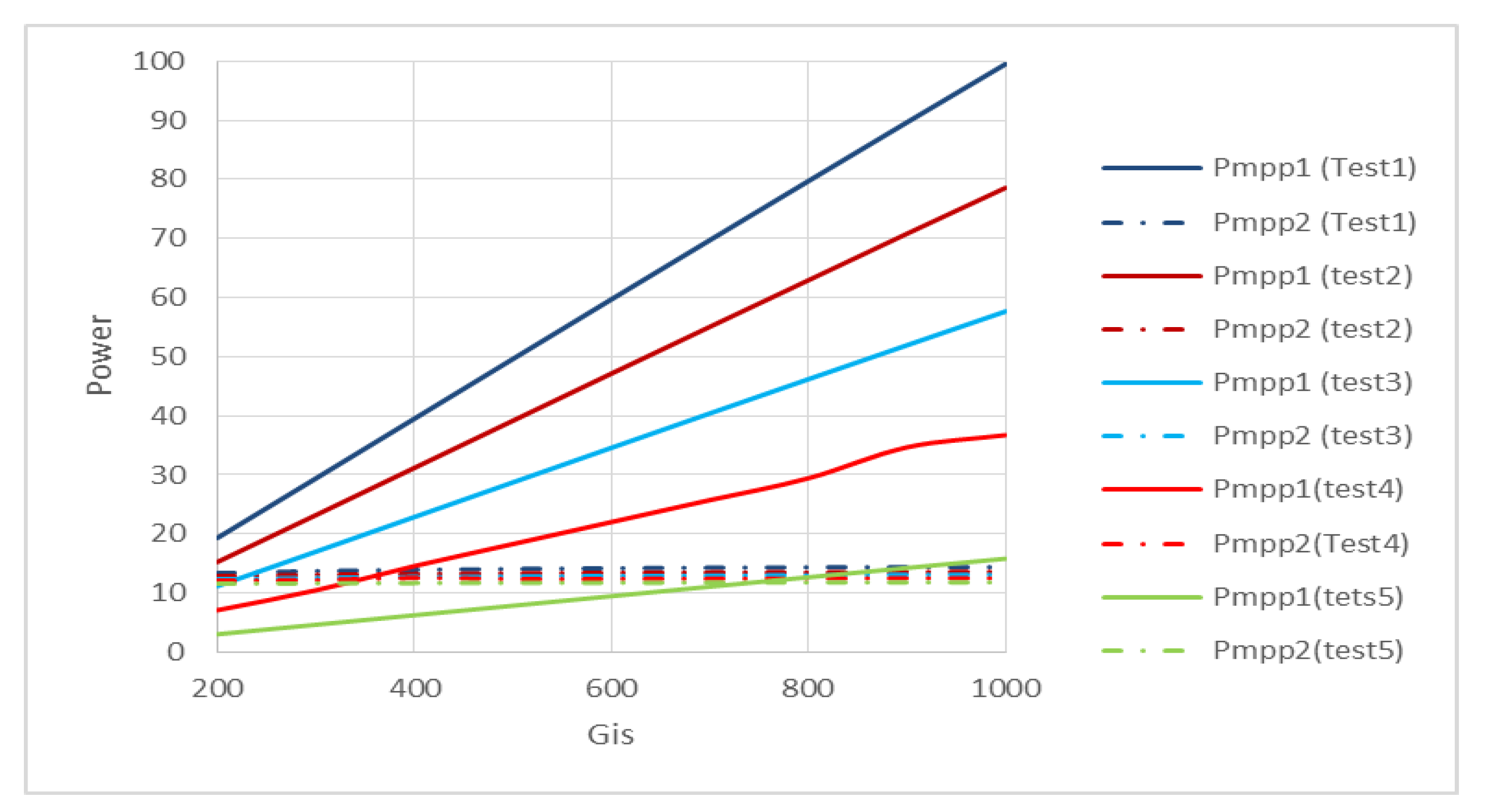
| TDC-M20-36 PV Panel at STC | |
|---|---|
| Maximum power | 20 W |
| Maximum voltage | 18.76 V |
| Maximum current | 1.07 A |
| Short-circuit current | 1.17 A |
| Open-circuit voltage | 22.70 V |
| Temperature coefficient of open-circuit voltage | −0.35%/°C |
| Temperature coefficient of short-circuit current | −0.043%/°C |
| Number of cells | 36 |
| Type of cells | Monocrystalline |
| Number of Shaded Panels | The Unshaded Panel Irradiance (W/m2) | The Shaded Panel Irradiance (W/m2) | |
|---|---|---|---|
| Test 1 | 1 | 200–1000 | 100 |
| Test 2 | 2 | 200–1000 | 100 |
| Test 3 | 3 | 200–1000 | 100 |
| Test 4 | 4 | 200–1000 | 100 |
| Test 5 | 5 | 200–1000 | 100 |
| Gis | Pmpp1 (W) | Vmpp1 (V) | Vmpp1 (V) Estimate | Error | Pmpp2 (W) | Vmpp2 (V) | Vmpp2 (V) Estimate | Error |
|---|---|---|---|---|---|---|---|---|
| 200 | 19.33 | 89.86 | 90.35 | 0.49 | 13.29 | 118.1 | 109.26 | 8.84 |
| 300 | 29.41 | 90.97 | 91.6 | 0.63 | 13.65 | 121.1 | 110.76 | 10.34 |
| 400 | 39.51 | 91.89 | 92.3 | 0.41 | 13.86 | 123.3 | 111.6 | 11.7 |
| 500 | 49.62 | 92.52 | 93.05 | 0.47 | 14.01 | 124.4 | 112.5 | 11.9 |
| 600 | 59.7 | 92.74 | 93.2 | 0.54 | 14.13 | 125.4 | 112.68 | 12.54 |
| 700 | 69.74 | 92.94 | 93.35 | 0.59 | 14.22 | 126.4 | 112.86 | 13.54 |
| 800 | 79.72 | 93.17 | 93.45 | 0.28 | 14.3 | 127.1 | 112.98 | 14.12 |
| 900 | 89.65 | 93.15 | 93.55 | 0.40 | 14.32 | 128.4 | 113.1 | 15.3 |
| 1000 | 99.51 | 93.12 | 93.65 | 0.49 | 14.33 | 129.2 | 113.22 | 15.98 |
| Gis | Pmpp1 (W) | Vmpp1 (V) | Vmpp1 (V) Estimate | Error | Pmpp2 (W) | Vmpp2 (V) | Vmpp2 (V) Estimate | Error |
|---|---|---|---|---|---|---|---|---|
| 200 | 15.26 | 71.07 | 71.56 | 0.49 | 12.81 | 114.7 | 109.26 | 5.44 |
| 300 | 23.21 | 72.5 | 72.56 | 0.06 | 13.1 | 117.5 | 110.76 | 6.74 |
| 400 | 31.19 | 72.96 | 73.12 | 0.16 | 13.26 | 119.1 | 111.6 | 7.5 |
| 500 | 39.18 | 73.07 | 73.72 | 0.65 | 13.38 | 120.2 | 112.5 | 7.7 |
| 600 | 47.14 | 73.34 | 73.75 | 0.41 | 13.47 | 121.2 | 112.68 | 8.52 |
| 700 | 55.07 | 73.33 | 73.85 | 0.52 | 13.55 | 121.6 | 112.86 | 8.74 |
| 800 | 62.94 | 73.95 | 73.92 | 0.03 | 13.55 | 123.3 | 112.98 | 10.32 |
| 900 | 70.81 | 73.61 | 74.00 | 0.61 | 13.64 | 123.4 | 113.1 | 10.3 |
| 1000 | 78.58 | 73.48 | 74.08 | 0.60 | 13.68 | 123.9 | 113.22 | 10.68 |
| Gis | Pmpp1 (W) | Vmpp1 (V) | Vmpp1 (V) Estimate | Error | Pmpp2 (W) | Vmpp2 (V) | Vmpp2 (V) Estimate | Error |
|---|---|---|---|---|---|---|---|---|
| 200 | 11.19 | 52.08 | 52.62 | 0.54 | 12.4 | 112.8 | 109.26 | 3.54 |
| 300 | 17.02 | 53.21 | 53.37 | 0.16 | 12.61 | 114.6 | 110.76 | 3.86 |
| 400 | 22.88 | 53.41 | 53.79 | 0.38 | 12.74 | 115.2 | 111.6 | 3.6 |
| 500 | 28.74 | 53.64 | 54.24 | 0.60 | 12.83 | 115.8 | 112.5 | 3.3 |
| 600 | 34.58 | 53.72 | 54.24 | 0.52 | 12.87 | 117.6 | 112.68 | 4.92 |
| 700 | 40.41 | 53.95 | 54.33 | 0.62 | 12.94 | 117.7 | 112.86 | 5.02 |
| 800 | 46.19 | 54.23 | 54.39 | 0.16 | 12.99 | 118.2 | 112.98 | 5.34 |
| 900 | 51.95 | 54.1 | 54.45 | 0.35 | 13.04 | 118.1 | 113.1 | 5 |
| 1000 | 57.66 | 54.07 | 54.51 | 0.44 | 13.05 | 119.1 | 113.22 | 5.88 |
| Gis | Pmpp1 (W) | Vmpp1 (V) | Vmpp1 (V) Estimate | Error | Pmpp2 (W) | Vmpp2 (V) | Vmpp2 (V) Estimate | Error |
|---|---|---|---|---|---|---|---|---|
| 200 | 7.11 | 33.25 | 33.68 | 0.43 | 12.03 | 110.2 | 109.26 | 0.94 |
| 300 | 10.48 | 33.72 | 34.18 | 0.46 | 12.17 | 111.4 | 110.76 | 0.64 |
| 400 | 14.57 | 33.92 | 34.46 | 0.54 | 12.52 | 112.2 | 111.6 | 0.6 |
| 500 | 18.31 | 34.33 | 34.76 | 0.43 | 12.31 | 112.6 | 112.5 | 0.1 |
| 600 | 22.03 | 34.3 | 34.76 | 0.46 | 12.35 | 113.6 | 112.68 | 0.92 |
| 700 | 25.74 | 34.43 | 34.82 | 0.39 | 12.39 | 113.6 | 112.86 | 0.32 |
| 800 | 29.43 | 34.48 | 34.86 | 0.38 | 12.42 | 113.3 | 112.98 | 0.33 |
| 900 | 34.67 | 34.09 | 34.9 | 0.81 | 12.45 | 114.1 | 113.1 | 1 |
| 1000 | 36.73 | 34.54 | 34.94 | 0.40 | 12.47 | 114.5 | 113.22 | 1.28 |
| Gis | Pmpp1 (W) | Vmpp1 (V) | Vmpp1 (V) Estimate | Error | Pmpp2 (W) | Vmpp2 (V) | Vmpp2 (V) Estimate | Error |
|---|---|---|---|---|---|---|---|---|
| 200 | 3.04 | 14.10 | 14.74 | 0.64 | 11.69 | 107.9 | 109.26 | 1.36 |
| 300 | 4.65 | 14.54 | 14.99 | 0.45 | 11.76 | 108.8 | 110.76 | 1.96 |
| 400 | 6.26 | 14.82 | 15.13 | 0.31 | 11.8 | 108.8 | 111.6 | 2.8 |
| 500 | 7.88 | 14.89 | 15.25 | 0.36 | 11.83 | 109.3 | 112.5 | 3.2 |
| 600 | 9.48 | 14.95 | 15.28 | 0.33 | 11.85 | 109.8 | 112.68 | 2.9 |
| 700 | 11.09 | 15.02 | 15.31 | 0.29 | 11.87 | 109.6 | 112.86 | 3.26 |
| 800 | 12.68 | 14.97 | 15.33 | 0.64 | 11.89 | 109.5 | 112.98 | 3.48 |
| 900 | 14.26 | 15.05 | 15.35 | 0.30 | 11.9 | 110.2 | 113.1 | 3.12 |
| 1000 | 15.83 | 14.98 | 15.37 | 0.39 | 11.91 | 110.1 | 113.22 | 3.11 |
Publisher’s Note: MDPI stays neutral with regard to jurisdictional claims in published maps and institutional affiliations. |
© 2021 by the authors. Licensee MDPI, Basel, Switzerland. This article is an open access article distributed under the terms and conditions of the Creative Commons Attribution (CC BY) license (https://creativecommons.org/licenses/by/4.0/).
Share and Cite
Chalh, A.; El Hammoumi, A.; Motahhir, S.; El Ghzizal, A.; Derouich, A.; Masud, M.; AlZain, M.A. Investigation of Partial Shading Scenarios on a Photovoltaic Array’s Characteristics. Electronics 2022, 11, 96. https://doi.org/10.3390/electronics11010096
Chalh A, El Hammoumi A, Motahhir S, El Ghzizal A, Derouich A, Masud M, AlZain MA. Investigation of Partial Shading Scenarios on a Photovoltaic Array’s Characteristics. Electronics. 2022; 11(1):96. https://doi.org/10.3390/electronics11010096
Chicago/Turabian StyleChalh, Abdelilah, Aboubakr El Hammoumi, Saad Motahhir, Abdelaziz El Ghzizal, Aziz Derouich, Mehedi Masud, and Mohammed A. AlZain. 2022. "Investigation of Partial Shading Scenarios on a Photovoltaic Array’s Characteristics" Electronics 11, no. 1: 96. https://doi.org/10.3390/electronics11010096
APA StyleChalh, A., El Hammoumi, A., Motahhir, S., El Ghzizal, A., Derouich, A., Masud, M., & AlZain, M. A. (2022). Investigation of Partial Shading Scenarios on a Photovoltaic Array’s Characteristics. Electronics, 11(1), 96. https://doi.org/10.3390/electronics11010096







